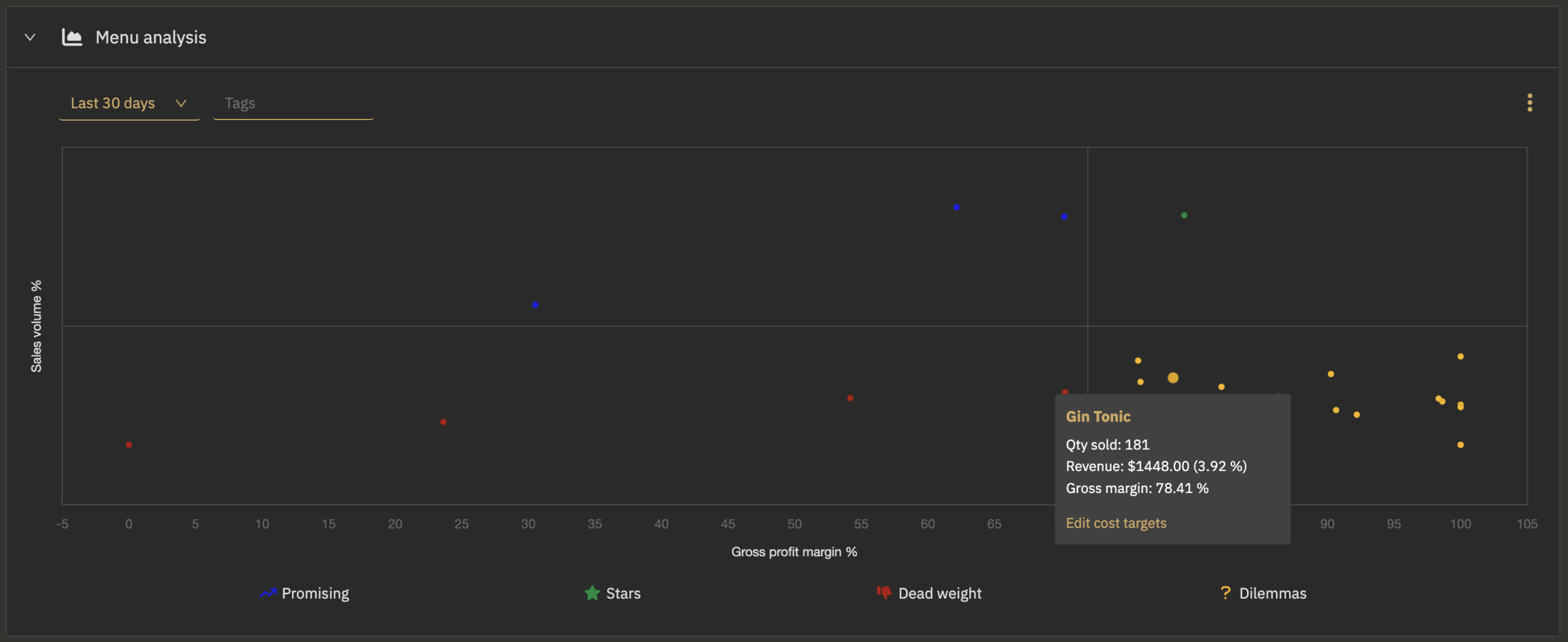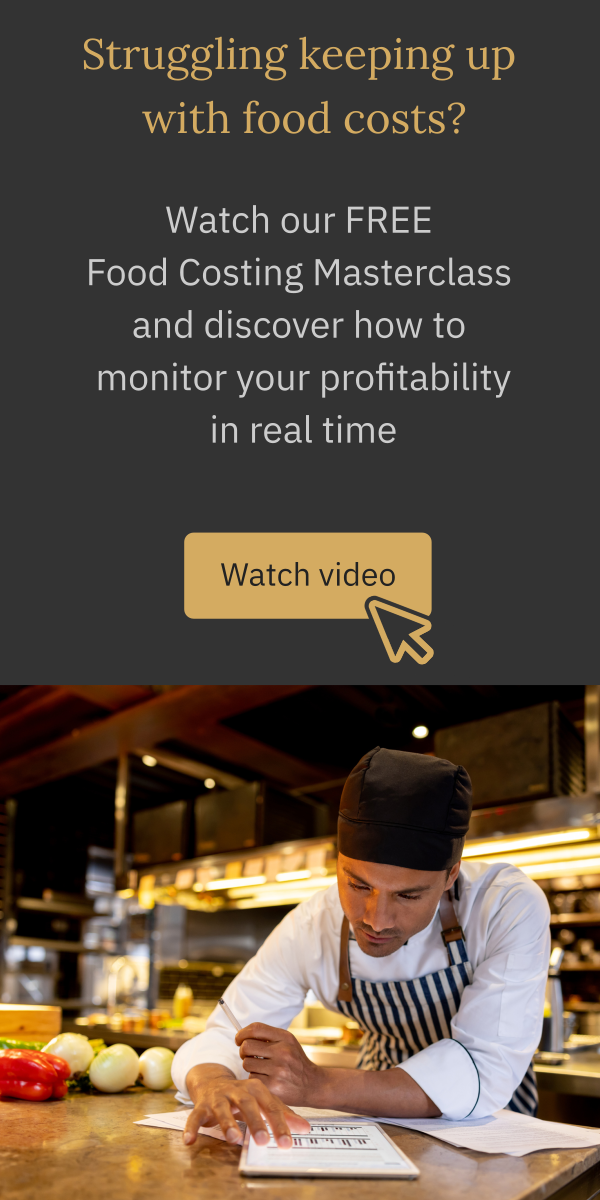Stay in the loop
Table of Contents
- 1 Why Menu Analysis Matters for Profitability
- 2 Essential Menu Analysis Metrics
- 3 Technique 1: Menu Engineering Chart
- 4 Technique 2: Liquor Bottle Tare Weight Tracking
- 5 Technique 3: Item-Level Food Costing with Nested Recipes
- 6 Technique 4: Promote Based on Contribution Margin
- 7 Technique 5: Overcome Static Pricing with AI Invoice Imports
- 8 Technique 6: Digital Menu Optimization
- 9 Common Mistakes to Avoid
- 10 Case Study: 18% Profit Boost from Menu Optimization
- 11 How to Start Your Menu Optimization
- 12 Let Your Menu Work Harder for You
In the competitive hospitality and food service industry, managing a profitable restaurant goes far beyond creating a delicious menu. Menu analysis, the strategic review of what you offer, how it performs, and its associated costs, is one of the most valuable tools for increasing both sales and profitability.
In this article, we’ll explore proven restaurant menu analysis techniques that can help you drive smarter pricing, reduce waste, and identify what truly contributes to your bottom line. We’ll also show how RapidStock, a modern restaurant inventory and food costing app, simplifies the entire process from item-level costing to supplier invoice automation.
Why Menu Analysis Matters for Profitability
Restaurants today face tight margins. With food costs averaging 28–35% of total revenue and fluctuating ingredient prices, smart operators must look beyond surface-level sales to understand where profits are made and lost.
Menu analysis helps answer questions like:
- Which menu items are profitable?
- Which are popular but underperforming?
- What needs to be priced differently—or removed?
Done right, it supports better decisions and a healthier bottom line.
Essential Menu Analysis Metrics
Before we get into techniques, here are the key data points every restaurant should track:
| Metric | Description |
| Food Cost % | (Cost of Goods Sold / Menu Price) × 100 – Target: 28–35% |
| Contribution Margin | Menu Price – Food Cost – Reveals profit per item |
| Sales Volume | Number of times an item is sold |
| Menu Mix % | What percent of total sales does each item represent |
Tracking these manually can be tedious, but software like RapidStock automates this process, ensuring data accuracy and providing real-time updates.
Technique 1: Menu Engineering Chart

One of the most effective strategies for visualizing item performance is the menu engineering matrix. While many systems use the traditional “Stars, Plowhorses, Puzzles, Dogs,” RapidStock offers a refined approach with these categories:
| Category | Description | What to Do |
| Stars | High profitability, high popularity | Promote heavily and highlight on the menus |
| Promising | Low profitability, high popularity | Improve margins through re-costing or portion adjustments |
| Dilemmas | High profitability, low popularity | Rebrand, rename, or reposition to increase visibility |
| Dead Weight | Low profitability, low popularity | Consider removing unless essential for the brand |
By classifying items in this way within RapidStock, restaurants can act on clear, visual insights rather than relying on guesswork.
Technique 2: Liquor Bottle Tare Weight Tracking
For bars and restaurants with beverage service, tracking liquor usage is key to minimizing overpouring, theft, and spoilage.
RapidStock Simplifies This Process
- When a user scans or adds a product’s barcode, RapidStock checks its community-driven product database.
- If full or empty bottle weights are available, the user is automatically notified.
- This enables the accurate tracking of how much product is being used compared to how much is being sold.
With precise tare weights and usage data, bar inventory becomes smarter, waste is reduced, and profitability increases.

Technique 3: Item-Level Food Costing with Nested Recipes
Menu item costing is the backbone of menu profitability. In RapidStock, costing is more potent than simply listing ingredients; you can also create and nest recipes.
Example
For a Chicken Caesar Salad:
Chicken
$2.40
Lettuce
$0.75
Croutons
$0.35
Dressing
Instead of entering dressing cost manually, link to a Dressing Recipe, which itself includes:
- Oil, vinegar, mustard, spices, and other ingredients.
- The total dressing batch cost is broken down to per-serving cost.
You can nest recipes within recipes, enabling precise costing even in complex prep workflows. This is ideal for kitchens that batch-produce sauces, soups, or marinades.
By doing so, RapidStock allows you to understand actual food cost, not just ingredient cost, making your food costing app an intelligent profitability engine.
Technique 4: Promote Based on Contribution Margin
Instead of always highlighting popular items, promote based on contribution margin (CM), the profit per item sold.
Example
| Dish | Cost | Price | CM |
| Burger | $4.50 | $12.00 | $7.50 |
| Salmon | $6.50 | $18.00 | $11.50 |
| Alfredo Pasta | $3.00 | $13.00 | $10.00 |
While burgers may sell more, salmon or pasta generate more profit per plate. Using menu engineering, you can identify and promote your highest-CM items to increase revenue without increasing effort.
RapidStock’s reporting tools make these figures easy to access and act on.
Technique 5: Overcome Static Pricing with AI Invoice Imports
One of the most overlooked challenges in restaurant pricing is the use of static menu pricing, which fails to reflect the rising costs of suppliers. This erodes profit margins over time.
RapidStock Solves This With an Exclusive Feature
- Restaurants can forward their supplier invoices to a unique RapidStock email address.
- A built-in AI agent analyzes invoice lines and suggests item-level imports.
- Once approved, ingredient prices and recipe costs are automatically updated.
- You can even set up notifications when a recipe exceeds its target margin.
This is a game-changer for restaurant operators. It keeps costing accurate and eliminates the need for manual updates every time prices change.
Technique 6: Digital Menu Optimization
Where and how you display items affect what people buy.
Menu engineering insights from RapidStock should guide your layout:
- Place Stars and Dilemmas in high-visibility zones
- Use boxes, icons, or callouts to make high-margin items stand out
- Group less profitable items in areas of reduced attention
Pairing menu layout strategies with real data makes every customer touchpoint more strategic and more profitable.
Common Mistakes to Avoid
Here’s what often derails menu optimization efforts:
| Mistake | How RapidStock Helps |
| Focusing only on popularity | Contribution margin analysis & menu matrix |
| Ignoring ingredient cost changes | AI invoice import updates recipes in real time |
| Underestimating recipe complexity | Nested recipes allow accurate batch cost tracking |
| Manual liquor tracking | Barcode scan pulls tare weights from the community database |
| Static pricing | Set notifications for margin alerts |
With RapidStock’s automation and reporting tools, these common pitfalls are easily avoided.
Case Study: 18% Profit Boost from Menu Optimization
A mid-sized restaurant group in Quebec implemented RapidStock’s menu analysis tools over 90 days.
Key Actions
- Loaded all ingredient and supplier invoice data
- Mapped menu using RapidStock’s Stars / Promising / Dilemmas / Dead Weight matrix
- Adjusted prices and portions
- Promoted high-margin items using in-menu callouts
- Automated invoice imports to keep prices current
Results
- 18% increase in profit per plate
- 12% reduction in food waste
- Complete costing transparency across the entire kitchen
This is what happens when technology meets strategy.
How to Start Your Menu Optimization
Getting started doesn’t require a full operations overhaul. Follow these steps to integrate menu analysis into your process:
- Connect your food, bar, or event inventory to RapidStock
- Add ingredients and start nesting recipes
- Scan product barcodes for community-sourced tare weights
- Import supplier invoices via email to update costs automatically
- Use the engineering matrix to assess and act on menu performance
Whether you run a single café or a multi-location restaurant group, these tools scale with your business.

Let Your Menu Work Harder for You
Make Every Item Count with RapidStock
Menu analysis is no longer optional; it’s essential for sustainable profitability. With RapidStock, you don’t just track food and liquor inventory. You optimize every menu item with real-time data, community insights, and AI-powered cost updates.
By using RapidStock’s advanced food costing app, you’ll:
- Identify profitable menu items with confidence
- Automate supplier cost updates and margin alerts
- Accurately track bar inventory with tare weight tools
- Nest complex recipes for exact portion-level costing
- Visualize and act on performance through smart engineering charts
Ready to drive smarter menu decisions?
Start your journey with RapidStock.
Talk to an expert at RapidStock and start making data-driven decisions today.
About the author
Fabrice Tremblay
Fabrice founded RapidStock in 2017 after working as a production planner for almost two decades. Briefly a bar owner and tech lover, he was inspired by the challenge of helping passionate entrepreneurs in the bars and restaurants industry.
When not working on RapidStock, Fabrice enjoys cooking and spending time outdoors with friends and family.
More tips and tricks


